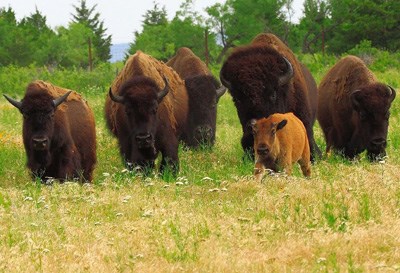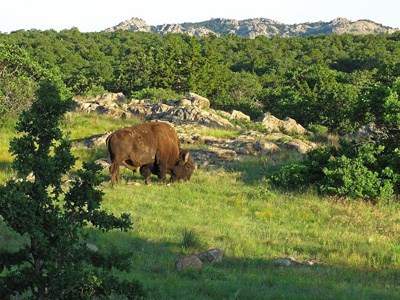Last updated: November 6, 2017
Article
Bison Bellows: Wichita Mountains Wildlife Refuge

Photo courtesy of R. Jones/US Fish and Wildlife Service
Located in southwestern Oklahoma, the Wichita Mountains Wildlife Refuge occupies part of an ancient range of granite mountains that rise out of the southern prairies of the region. The Refuge encompasses over 59,000 acres of native mixed-grassed prairie, oak forests, and rugged rockland habitats, along with a diverse array of wildlife species that are dependent on these habitats. Originally established as a forest preserve in 1901, the area was re-designated as a national game preserve in 1905. Wichita Mountains was then added to the National Wildlife Refuge System in 1936, and today, the Refuge supports a variety of wildlife native to the southern Great Plains, including the American plains bison.
Refuges were established with a variety of purposes, a part of what makes each Refuge unique. For Wichita Mountains, the Refuge was established to protect wildlife species in danger of extinction as well as to restore those species that had been eliminated from the area---the American bison representing one of these species. In 1907, Wichita Mountains received 15 bison from the New York Zoological Park to re-establish a southern plains herd, thanks to the conservation efforts of the American Bison Society and the New York Zoological Society. These 15 bison contributed to the long-term survival of the roughly 650 bison that roam freely today in the Refuge. Today, Wichita Mountains constitutes the largest bison refuge managed by the U.S. Fish and Wildlife Service. Beginning in 1927, Texas longhorn cattle were also brought to the refuge for the long-term preservation of this historically significant breed of cattle. While the cattle and bison herds do often mix at favorable grazing areas, there are no records of hybridizations or interbreeding between the longhorns and bison on the Refuge. These two species are two parts of what makes Wichita Mountains Wildlife Refuge special.

Photo courtesy of N. Axelsen/US Fish and Wildlife Service
Since inclusion in the Refuge system during the Dust Bowl era, Wichita Mountains habitats and wildlife have experienced periodic drought and wildfire that created this diverse landscape. Drought has been a recent and ongoing concern since 2010 and a large portion of the Refuge burned in 2011, but these ecological drivers create and maintain southern mixed-grass prairie in which bison thrive. Today, roughly 220 Texas longhorn cattle and roughly 650 bison coexist with more than 240 species of birds, 64 species of reptiles and amphibians, and 50 species of mammals including Rocky Mountain elk, white-tailed deer, bobcat, coyote, and fox.
Maintaining a healthy, genetically diverse herd is an important objective, and the Refuge staff collect hair and blood samples from bison during the annual roundup for genetic analysis and disease testing. Bison that are more closely related to the rest of the herd are selected for sale or donation, while bison with less genetic representation in the herd are retained for conservation. Wichita Mountains bison have also been introduced into two of the northern Refuge bison herds to increase genetic diversity, perhaps bringing additional resilience to the harsh extremes of drought and fire back to the north.
